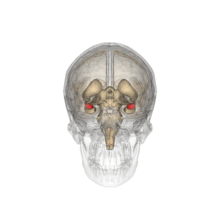
Getting caught in a small hole, due to cave-ins or suddenly finding the den of a dangerous animal, could have caused claustrophobia to become a prepared phobia.
Claustrophobia (from
Latin claustrum "a shut in place" and Greek
φόβος,
phóbos, "fear") is the fear of having no escape and being closed in small spaces or rooms (opposite:
claustrophilia). It is typically classified as an
anxiety disorder and often results in
panic attack, and can be the result of many situations or
stimuli, including elevators crowded to capacity, windowless rooms, and even tight-necked clothing
. The onset of claustrophobia has been attributed to many factors, including a reduction in the size of the
amygdala, classical conditioning, or a genetic predisposition to fear small spaces.
One study indicates that anywhere from 5–7% of the world population is affected by severe claustrophobia, but only a small percentage of these people receive some kind of treatment for the disorder.
Basic symptoms of claustrophobia
Claustrophobia is typically thought to have two key symptoms: fear of restriction and fear of
suffocation. A typical claustrophobic will fear restriction in at least one, if not several, of the following areas: small rooms, locked rooms, cars, tunnels, cellars,
elevators, subway trains, caves, airplanes and crowded areas. Additionally, the fear of restriction can cause some claustrophobics to fear trivial matters such as sitting in a barber’s chair or waiting in line at a grocery store simply out of a fear of confinement to a single space.
However, claustrophobics are not necessarily afraid of these areas themselves, but, rather, they fear what could happen to them should they become confined to an area. Often, when confined to an area, claustrophobics begin to fear suffocation, believing that there may be a lack of air in the area to which they are confined.
Many claustrophobics remove clothing during attacks, believing it will relieve the symptoms. Any combination of the above symptoms can lead to severe
panic attacks. However, most claustrophobics do everything in their power to avoid these situations.
Diagnosis
Claustrophobia is the fear of having no escape, and being closed in. It is typically classified as an anxiety disorder and often results in a rather severe panic attack. One study conducted by University of Wisconsin-Madison’s neurology department revealed that anywhere from 2-5% of the world population is affected by severe claustrophobia, but only a small percentage of these people receive some kind of treatment for the disorder.
Claustrophobia develops as the mind makes the association that small spaces psychologically translate to some imminent danger. This typically occurs as a result of a traumatic past experience (such as being trapped in a dark, small space and thinking that there is no way out because the mind is not fully developed enough to realize there is a way out) or from another unpleasant experience occurring later on in life involving confined spaces. These two causes of claustrophobia both reject the common misconception that claustrophobia is a genetic disorder.
In fact claustrophobia is a conditioned response to a stimulus. It results from when an individual associates a tremendous amount of anxiety and a panic attack with a confined space. That event, the confined space, serves as a trigger or the stimulus, which is programmed into the brain. Because that stimulus is programmed into the brain, so is the response, which in this case, is a tremendous amount of anxiety. As a result, the confined space consistently triggers the same anxious response.
Claustrophobia scale
This method was developed in 1979 by interpreting the files of patients diagnosed with claustrophobia and by reading various scientific articles about the diagnosis of the disorder. Once an initial scale was developed, it was tested and sharpened by several experts in the field. Today, it consists of 20 questions that determine
anxiety levels and desire to avoid certain situations. Several studies have proved this scale to be effective in claustrophobia diagnosis.
Claustrophobia questionnaire
This method was developed by Rachman and Taylor, two experts in the field, in 1993. This method is effective in distinguishing symptoms stemming from fear of
suffocation and fear of restriction. In 2001, it was modified from 36 to 24 items by another group of field experts. This study has also been proved very effective by various studies.
Causes of claustrophobia
The fear of enclosed spaces is an
irrational fear. Most claustrophobic people who find themselves in a room without windows consciously know that they aren’t in danger, yet these same people will be afraid, possibly terrified to the point of incapacitation, and many do not know why. The exact cause of claustrophobia is unknown, but there are many theories
Amygdala

The red structure is the amygdala.
The
amygdala is one of the smallest structures in the
brain, but by far one of the most powerful. The amygdala is needed for the conditioning of
fear, or the creation of a
fight-or-flight response. A fight-or-flight response is created, when a stimulus is associated with a grievous situation
. A
phobia’s roots are in this fight-or-flight response.
In generating a fight-or-flight response, the amygdala acts in the following way: The amygdala’s anterior
nuclei associated with fear communicate with each other. Nuclei send out impulses to other nuclei, which influence respiratory rate, physical arousal, the release of
adrenaline, blood pressure, heart rate, behavioral fear response, and defensive responses, which may include freezing up. These reactions constitute an ‘autonomic failure’ in a panic attack
.
A study done by Fumi Hayano found that the right amygdala was smaller in patients who suffered from panic disorders. The reduction of size occurred in a structure known as the corticomedial nuclear group which the CE nucleus belongs to. This causes interference, which in turn causes abnormal reactions to aversive stimuli in those with panic disorders. In claustrophobic people, this translates as panicking or overreacting to a situation in which the person finds themselves physically confined.
Classical Conditioning
“Claustrophobia develops as the mind makes the association that small spaces psychologically translate to some imminent danger
.” It often comes as a consequence of a traumatic childhood experience
, although the onset can come at any point in an individual’s life. Such an experience can occur multiple times, or only once, to make a permanent impression on the mind . The majority of claustrophobic participants in an experiment done by Lars-Göran Öst reported that their phobia had been “acquired as a result of a conditioning experience
." In most cases, claustrophobia seems to be the result of past experiences.
Conditioning experiences
A few examples of common experiences that could result in the onset of claustrophobia in children (or adults) are as follows:
- A child (or, less commonly, an adult) is shut into a pitch-black room and cannot find the door or the light-switch.
- A child gets shut into a box.
- A child falls into a deep pool and cannot swim.
- A child gets separated from their parents in a large crowd and gets lost.
- A child sticks their head between the bars of a fence and then cannot get back out.
- A child crawls into a hole and gets stuck, or cannot find their way back.
The term ‘past experiences,’ according to one author, can extend to the moment of birth. In John A. Speyrer’s ‘’Claustrophobia and the Fear of Death and Dying,’’ the reader is brought to the conclusion that claustrophobia’s high frequency is due to birth trauma, about which he says is “one of the most horrendous experiences we can have during our lifetime,” and it is in this helpless moment that the infant develops claustrophobia

A crowd such as this could cause the onset of claustrophobia in a child
Magnetic resonance imaging, or the
MRI, has been attributed to the onset of claustrophobia. Since a patient has to be put into the center of a
magnet to optimize imaging, the patient finds themselves in a narrow tube for an extended period of time. In a study involving claustrophobia and the MRI, it was reported that 13% of patients experienced a panic attack during the procedure. The procedure has been linked not only to the triggering of ‘preexisting’ claustrophobia, but also to the onset in some people
. These panic attacks during the procedure make it so the patient is unable to adjust to the situation, and therefore the fear remains
.

In an MRI, the patient is inserted into the tube

The Conditions inside a Mine
S.J. Rachman tells of an extreme example is found in the experience of 21 miners in the Claustrophobia section of ‘’Phobias: A Handbook of Theory, Research, and Treatment.’’ These miners were trapped underground for 14 days, during which six of the miners died of suffocation. After their rescue, ten of the miners were studied for ten years. All but one were greatly changed by the experience, and six of those developed phobias, phobias that involved “confining or limiting situations.” The only miner who did not develop any noticeable symptoms was the one who acted as leader .
Another factor that could cause the onset of claustrophobia is “information received
.” As Aureau Walding states in ‘’Causes of Claustrophobia,’’ many people, especially children, learn who and what to fear by watching parents or peers. This method does not only apply to observing a teacher, but also observing victims. Vicarious classical conditioning also includes when a person sees another person exposed directly to an especially unpleasant situation
. This would be analogous to observing someone getting stuck in a tight space, suffocated, or any of the other examples that were listed above.
Prepared phobia
There is research that suggests that claustrophobia isn’t entirely a classically conditioned or learned phobia. It is not necessarily an inborn fear, but it is very likely what is called a 'prepared phobia.' As Erin Gersley says in ‘’Phobias: Causes and Treatments,’’ humans are genetically predisposed to become afraid of things that are dangerous to them. Claustrophobia may fall under this category because of its “wide distribution… early onset and seeming easy acquisition, and its non-cognitive features .” The acquisition of claustrophobia may be part of a
vestigial evolutionary survival mechanism , a dormant fear of entrapment and/or suffocation that was once important for the survival of humanity and could be easily awakened at any time . Hostile environments in the past would have made this kind of pre-programmed fear necessary, and so the human mind developed the capacity for “efficient fear conditioning to certain classes of dangerous stimuli
.”
Rachman provides a very strong argument for this theory in his article: ‘’Phobias.’’ He agrees with the statement that phobias generally concern objects that constitute a direct threat to human survival, and that many of these phobias are quickly acquired because of an “inherited biological preparedness
.” This brings about a prepared phobia, which is not quite innate, but is widely and easily learned. As Rachman explains in the article: “The main features of prepared phobias are that they are very easily acquired,
selective, stable, biologically significant, and probably [non-cognitive].” ‘Selective’ and ‘biologically significant’ mean that they only relate to things that directly threaten the health, safety, or survival of an individual. ‘Non-cognitive’ suggests that these fears are acquired unconsciously. Both factors point to the theory that claustrophobia is a prepared phobia that is already pre-programmed into the mind of a human being.
Treatment
Cognitive therapy
Cognitive therapy is a widely accepted form of treatment for most
anxiety disorders. It is also thought to be particularly effective in combating disorders where the patient doesn’t actually fear a situation but, rather, fears what could result from being in said situation.
The ultimate goal of cognitive therapy is to modify distorted thoughts or misconceptions associated with whatever is being feared; the theory is that modifying these thoughts will decrease
anxiety and avoidance of certain situations.
For example, cognitive therapy would attempt to convince a claustrophobic patient that elevators are not dangerous but are, in fact, very useful in getting you where you would like to go faster. A study conducted by S.J. Rachman shows that cognitive therapy decreased fear and negative thoughts/connotations by an average of around 30% in claustrophobic patients tested, proving it to be a reasonably effective method.
In vivo exposure
This method forces patients to face their fears by complete exposure to whatever fear they are experiencing.
This is usually done in a progressive manner starting with lesser exposures and moving upward towards severe exposures.
For example, a claustrophobic patient would start by going into an elevator and work up to an
MRI. Several studies have proven this to be an effective method in combating various
phobias, claustrophobia included.
S.J. Rachman has also tested the effectiveness of this method in treating claustrophobia and found it to decrease
fear and negative thoughts/connotations by an average of nearly 75% in his patients.
Of the methods he tested in this particular study, this was by far the most significant reduction.
Interoceptive exposure
This method attempts to recreate internal physical sensations within a patient in a controlled environment and is a less intense version of
in vivo exposure.
This was the final method of treatment tested by S.J. Rachman in his 1992 study.
It lowered fear and negative thoughts/connotations by about 25%.
These numbers did not quite match those of in vivo exposure or cognitive therapy, but still resulted in significant reductions.
Other forms of treatment that have also been shown to be reasonably effective are psychoeducation, counter-conditioning, regressive hypnotherapy and breathing re-training. Medications often prescribed to help treat claustrophobia include anti-depressants and beta-blockers, which help to relieve the heart-pounding symptoms often associated with anxiety attacks.
Studies
MRI procedure
Because they can produce a
fear of both
suffocation and restriction,
MRI scans often prove difficult for claustrophobic patients. In fact, estimates say that anywhere from 4–20% of patients refuse to go through with the scan for precisely this reason. One study estimates that this percentage could be as high as 37% of all MRI recipients.
The average
MRI takes around 50 minutes; this is more than enough time to evoke extreme
fear and
anxiety in a severely claustrophobic patient.
This study was conducted with three goals: 1. To discover the extent of
anxiety during an
MRI. 2. To find predictors for
anxiety during an
MRI. 3. To observe psychological factors of undergoing an
MRI. Eighty patients were randomly chosen for this study and subjected to several diagnostic tests to rate their level of claustrophobic
fear; none of these patients had previously been diagnosed with claustrophobia. They were also subjected to several of the same tests after their
MRI to see if their
anxiety levels had elevated. This experiment concludes that the primary component of
anxiety experienced by patients was most closely connected to claustrophobia.
This assertion stems from the high Claustrophobic Questionnaire results of those who reported
anxiety during the scan. Almost 25% of the patients reported at least moderate feelings of
anxiety during the scan and 3 were unable to complete the scan at all. When asked a month after their scan, 30% of patients (these numbers are taken of the 48 that responded a month later) reported that their claustrophobic feelings had elevated since the scan. The majority of these patients claimed to have never had claustrophobic sensations up to that point. This study concludes that the Claustrophobic Questionnaire (or an equivalent method of
diagnosis) should be used before allowing someone to have an
MRI.
Use of Virtual Reality Distraction to Reduce Claustrophobia
The present case series with two patients explored whether
virtual reality (VR) distraction could reduce claustrophobia symptoms during a mock
magnetic resonance imaging (MRI) brain scan. Two patients who met
DSM-IV criteria for
specific phobia, situational type (i.e., claustrophobia) reported high levels of anxiety during a mock 10-min MRI procedure with no VR, and asked to terminate the scan early. The patients were randomly assigned to receive either VR or music distraction for their second scan attempt. When immersed in an illusory three-dimensional (3D) virtual world named SnowWorld, patient 1 was able to complete a 10-min mock scan with low anxiety and reported an increase in self-efficacy afterwards. Patient 2 received “music only” distraction during her second scan but was still not able to complete a 10-min scan and asked to terminate her second scan early. These results suggest that immersive VR may prove effective at temporarily reducing claustrophobia symptoms during MRI scans and music may prove less effective.
Many researchers have experimented with different types of phobia using VR. Researchers from Mediamatica Department,
Delft University of Technology in collaboration with
Faculty of Psychology, University of Amsterdam has also done several research projects on
virtual reality exposure therapy(VRET). The VR system used in the project is developed in
TU Delft. Several
Virtual environments (VE) has been developed for different kinds of phobia exposure. Two of the VEs are virtual fire stairs and rooftop terrace for the
acrophobia treatment. There are also VEs that are intended for claustrophobia treatment such as virtual hallway, virtual closet, and elevators. Virtual flight and virtual airport also has been developed for treating patients with
fear of flying. However VEs aimed at
social anxiety and
agoraphobia exposure therapy have not been developed in Mediamatica Department, TU Delft.
Virtual Reality (VR) allows a third option of exposure therapy in a virtual setting that is safer, less embarrassing, and less costly than reproducing the real world situations. Besides situations can be created that are difficult to find in real life and it’s more realistic than imagining the danger. Already some experiments have proven VR to be a useful tool in treating specific phobias such as fear of heights, fear of spiders, fear of flying and claustrophobia, as well as agoraphobia. However most research that is done on VR exposure consists of single case studies and controlled group studies are necessary to support the conclusions of case studies. Research in this area is still in its infancy, but is progressing rapidly.
To take Virtual Reality (graded) Exposure (VRE) from the experimental lab and into the daily practice of psychologists more research is needed. Delft University of Technology and the University of Amsterdam have taken up this challenge. Within four years we have built a fully functional system optimal for the given situation. Furthermore we have substantial data to support the effectiveness of VRE for the treatment of phobias (fear of heights, claustrophobia, fear of flying). The domain is being approached from these two angles:
Psychology Human Computer Interaction
Both angles are being represented by a group in the project team.
In 1999 we completed a pilot study with low budget VR equipment. The aim of this study was to evaluate the effectiveness of low-budget virtual reality exposure versus exposure in vivo in a within group design in ten individuals suffering from acrophobia (phobia of heights) (Emmelkamp, Bruynzeel, Drost & van der Mast).
Separating the fear of restriction and fear of suffocation
Many experts who have studied claustrophobia claim that it consists of two separable components:
fear of
suffocation and
fear of
restriction. In an effort to fully prove this assertion, a study was conducted by three experts in order to clearly prove a difference. The study was conducted by issuing a
questionnaire to 78 patients who received
MRI’s.
The data was compiled into a “
fear scale” of sorts with separate subscales for
suffocation and
confinement. Theoretically, these subscales would be different if the contributing factors are indeed separate. The study was successful in proving that the symptoms are separate. Therefore, according to this study, in order to effectively combat claustrophobia, it is necessary to attack both of these underlying causes.
However, because this study only applied to people who were able to finish their
MRI, those who were unable to complete the
MRI were not included in the study. It is likely that many of these people dropped out because of a severe case of claustrophobia. Therefore, the absence of those who suffer the most from claustrophobia could have skewed these statistics.
[24]
A group of students attending the
University of Texas at Austin were first given an initial diagnostic and then given a score between 1 and 5 based on their potential to have claustrophobia. Those who scored a 3 or higher were used in the study. The students were then asked how well they felt they could cope if forced to stay in a small chamber for an extended period of time. Concerns expressed in the questions asked were separated into
suffocation concerns and entrapment concerns in order to distinguish between the two perceived
causes of claustrophobia. The results of this study showed that the majority of students feared entrapment far more than
suffocation. Because of this difference in type of
fear, it can yet again be asserted that there is a clear difference in these two symptoms.
Probability ratings in claustrophobic patients and non-claustrophobics
This study was conducted on 98 people, 49 diagnosed claustrophobics and 49 "community controls" to find out if claustrophobics' minds are distorted by "
anxiety-arousing" events (i.e. claustrophobic events) to the point that they believe those events are more likely to happen. Each person was given three events—a claustrophobic event, a generally negative event, and a generally positive event—and asked to rate how likely it was that this event would happen to them. As expected, the diagnosed claustrophobics gave the claustrophobic events a significantly higher likelihood of occurring than did the
control group. There was no noticeable difference in either the positive or negative events. However, this study is also potentially flawed because the claustrophobic people had already been diagnosed.
[citation needed] Diagnosis of the disorder could likely
bias one’s belief that claustrophobic events are more likely to occur to them.
Sumber:
http://en.wikipedia.org/wiki/Claustrophobia






































